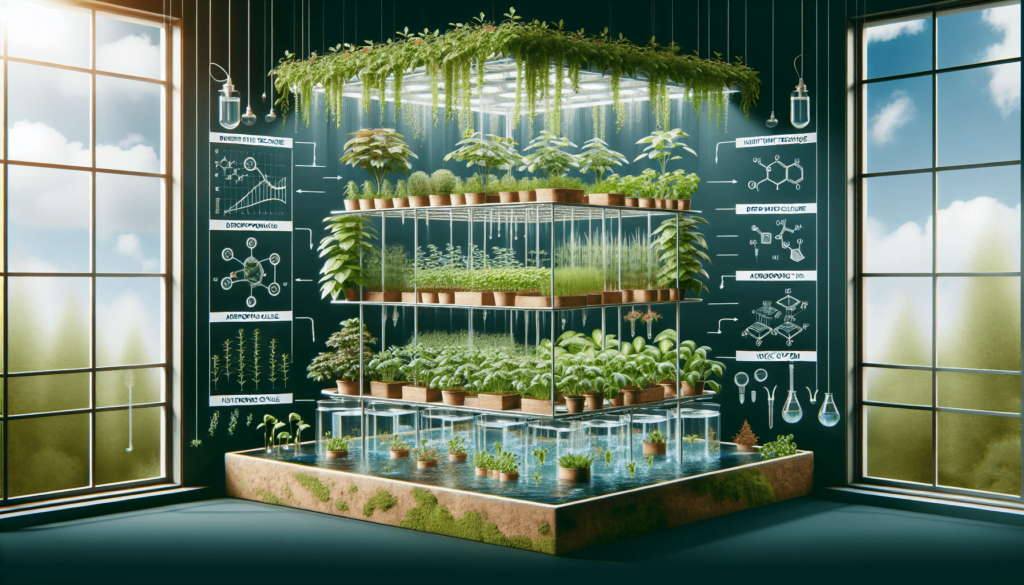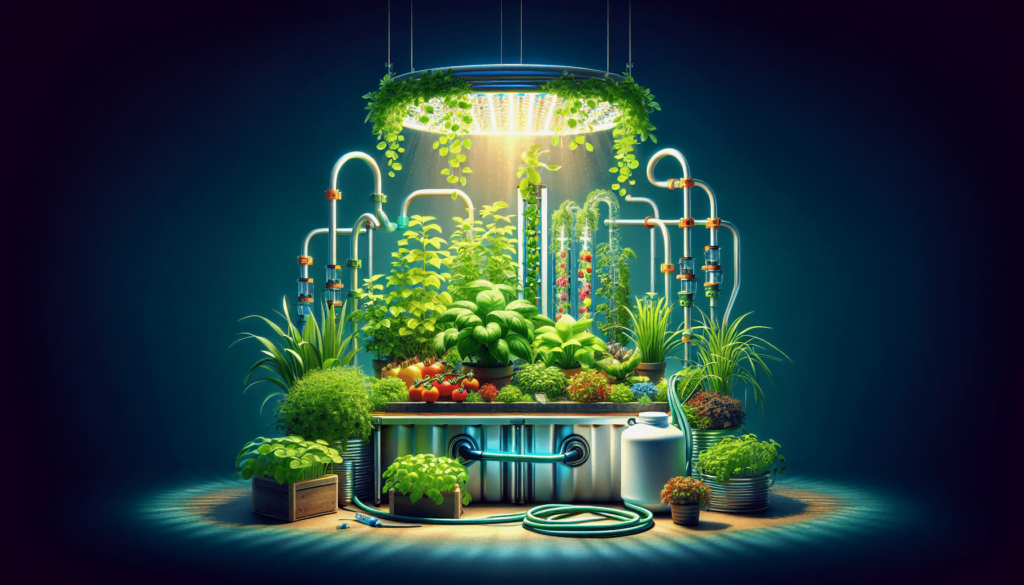Are you intrigued by plants growing without soil? Let’s demystify this unique method known as hydroponics. Imagine gaining the ability to cultivate lush, vibrant, and bountiful plants in your city apartment or backyard using just water and nutrients. In this enlightening article, the fascinating world of hydroponics is unraveled as we explain its fundamentals, its functioning, and its impact on modern-day agriculture. So sit back and prepare to be amazed as we travel into the future of gardening, where soil is no longer the king.
Definition of Hydroponics
An explanation of the term hydroponics
In simplest terms, hydroponics is the method of growing plants without soil. Alright, you might be thinking, “How can plants grow without soil?” Well, soil, per se, isn’t what plants need; they, in fact, need water, sunlight, CO2, and nutrients, all of which can be provided outside of the soil. Hydroponics delivers these essential elements directly to the root system of plants, immersing them in a nutrient-rich water solution, resulting in some amazing benefits.
Differences between traditional gardening and hydroponics
How does traditional gardening compare with hydroponics? Good question. In conventional gardening, roots must navigate through the soil to absorb nutrients and water. But with hydroponics, the nutrients come straight to the roots. It eliminates the need for the plants to expend energy in search of nutrients, thereby redirecting this energy into growth and productivity. Moreover, it facilitates control over the nutrient balance, resulting in yield with enhanced quality and taste.
History of Hydroponics
An early history of hydroponics, first uses in ancient civilizations
The concept of hydroponics isn’t new. Records of ancient civilizations like the Babylonians, with their Hanging Gardens, and the Aztecs, with their floating gardens, hint at hydroponic-like techniques. The use of hydroponics for productive farming, however, languished until the modern era.
The development of hydroponics in the 20th century
Hydroponics as we understand it today began taking shape around the early 20th century when scientists realized that plants take essential nutrients as inorganic ions in water. In the 1930s and 40s, Dr. William Frederick Gericke from the University of California popularized the term “hydroponics” and successfully demonstrated huge yield increases with this method.
Current trend and future perspective in hydroponics
In the past few years, hydroponics has grown increasingly popular, especially amidst urban enthusiasts and commercial growers, due to its sustainability and potential profitability. With ongoing technological advancements, the practice is poised to play a transformative role in the future of agriculture.

Types of Hydroponics Systems
Introduction to different types of hydroponic setups
Hydroponic setups vary, each with its unique advantages. The most common systems include Nutrient Film Technique (NFT), Ebb and Flow (or Flood and Drain), Aeroponics, and Deep Water Culture (DWC).
Detailed look into popular hydroponic systems including Nutrient Film Technique (NFT), Ebb and Flow, Aeroponics, and Deep Water Culture (DWC)
NFT involves a constant flow of nutrient solution over the exposed roots, while Ebb and Flow intermittently floods the root zone with nutrients. Aeroponics suspends plants in the air and sprays the roots with a nutrient solution, and DWC allows plant roots to be submerged in oxygenated water containing the nutrient solution.
Advantages and disadvantages of each type
Every system has its pros and cons. For instance, NFT is cost-effective but requires constant monitoring of pH and nutrient levels; Ebb and Flow provides excellent aeration but is susceptible to power failures; Aeroponics offers faster growth but requires high maintenance; DWC is simple to start with but struggles with larger plants.
Components of a Hydroponic System
Necessity of a growing medium in hydroponics
While soil is unnecessary in hydroponics, some sort of growing medium to support the plants and host the root system is required. The choice of medium (such as coconut coir, perlite, or rockwool) depends on the chosen hydroponic system and plant type.
Types of nutrient solutions used in hydroponics
In hydroponics, feeding the plants is done via water with dissolved nutrients. These nutrients are contained in commercial hydroponic solutions that do need to be properly mixed and balanced according to plant needs.
Importance of proper lighting
Without adequate light, plants can’t perform photosynthesis. Natural sunlight is ideal for hydroponics, though indoor systems utilize specialized grow lights to simulate daylight.
Water and air management
Being a water-based system, managing water quality is critical in hydroponics. Simultaneously, plants need oxygen for respiration, necessitating a delicate balance of air and water at the root zone.

The Hydroponic Plant Growth Process
How plants obtain nutrients in a hydroponic system
Plants grown hydroponically obtain nutrients directly from the enriched water solution. Their roots are either immersed in the solution or misted with it depending on the type of system used.
Way plants grow in hydroponic systems compared to conventional methods
The direct access to nutrients and water means plants in a hydroponic setup grow faster than their conventional counterparts. They also require less space allowing for a higher density of growth.
Use of pH and EC meters for controlling nutrient and water quality
Monitors and adjusts the pH and the electrical conductivity (EC) of the nutrient solution are crucial in hydroponics. It ensures that plants can efficiently uptake the nutrients.
Benefits of Using Hydroponics
Efficiency in usage of water and space
Hydroponics systems use significantly less water than traditional farming methods, conserving one of Earth’s most precious resources. Furthermore, more plants can be grown in less space, a boon for urban and indoor farmers.
Potential for faster plant growth and yield
As plants don’t have to exert energy in search of nutrients, they grow faster and yield more bountifully in the hydroponic setups.
Crop’s growth regardless of seasonal changes
Another advantage is the capability to grow crops irrespective of the season, as the indoor controls mean plants aren’t subjected to traditional seasonal cycles.
Elimination of soil-borne diseases and pests
Hydroponics also ideally eliminates soil-borne diseases and pests, reducing the need for harmful pesticides.
Challenges and Limitations of Hydroponics
Initial cost and learning curve associated with setting up a hydroponic system
The initial cost and technical knowledge required to start a hydroponic system can be daunting. It necessitates understanding various components and their interplay to keep the system successful.
Need for constant monitoring and maintenance
Successful hydroponics demands constant system monitoring and maintenance to avoid any imbalances that could harm the plants.
Potential for system breakdown leading to catastrophic losses
Being a synchronized system, any fault in lighting, temperature control, nutrient balance or water management could lead to catastrophic losses.
Hydroponics and Sustainability
Role of hydroponics in urban farming and vertical farming
Hydroponics is well-positioned to be at the forefront of urban farming and vertical farming trends, enabling city dwellers to grow fresh produce in small areas, even in high-rise buildings.
Impact of hydroponics on water and nutrient usage
Hydroponics uses less water and nutrients compared to traditional farming, thus reducing the environmental burden.
Possibility for implementation in future agricultural practices
With rising population and limited agricultural land, hydroponics could play a crucial role in sustainable food production in the future.
Applications of Hydroponics
Usage of hydroponics in commercial food production
Several large-scale farmers and businesses are already implementing hydroponics to produce fruits, vegetables, and herbs, offering markets fresh produce year-round.
Adoption of hydroponics in home gardening
Many individuals are embracing hydroponics for home gardening, benefitting from the fresh homegrown produce.
Potential role of hydroponics in space travel and colonization
NASA is researching hydroponics for space travel and potential colonization, given the method’s ability to grow crops in controlled environments without soil.
Getting Started with Hydroponics
Requirements for starting a home-based hydroponic system
Typically, a home-based hydroponic system would require some growing area, a light source, growing medium, plant containers, nutrient solution, water, and of course, the plants.
Step-by-step guide to building a simple hydroponic system
Starting a basic hydroponic setup at home includes choosing and preparing the grow area, setting up the grow light, preparing the growing medium and containers, mixing the nutrient solution, sowing the seeds or transplanting the plants, and maintaining the system.
Tips for maintaining and troubleshooting a hydroponic system
Regular checks and adjustments of pH and nutrient levels, ensuring proper light exposure, maintaining a clean and pest-free environment, and regular monitoring are some valuable tips for maintaining and troubleshooting a hydroponic system.
With an understanding of hydroponics and its possibilities, anyone can get involved in this promising approach to horticulture. The rewards, from the high-quality yield to the sustainability benefits, are worth the learning and efforts. Hydroponics represents a vibrant future for agriculture and food production. All it needs is our participation and push.
Forum
Got something to share or a question to ask? Jump in and start a conversation! Whether it’s tips, advice, or just sharing your experiences, we’d love to hear from you. Don’t be shy—your input could inspire or help someone else!- This forum has 1 topic, and was last updated 10 months, 1 week ago by .
- Topic
- Voices
- Last Post
- You must be logged in to create new topics.


